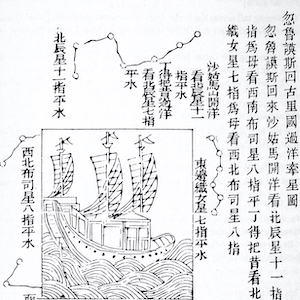Browse
Transportation

Review
Res Obscura
Functioning primarily as the personal blog of historian Benjamin Breen, Res Obscura stays true to its by-line by being ‘a catalogue of obscure things’.
Review
The Chinese Railroad Workers in North America Project
The Chinese Railroad Workers in America Project is an excellent, multi-faceted model of how rigorous academic research can embrace the digital turn to interface with the public in a clear and accessible way.
Source
Kilwa Map Illustration
This illustration shows the trading city state of Kilwa or Kilwa Kiswani on an island off the Swahili Coast in East Africa (modern Tanzania), which flourished between the 12th and 15th century.

Source
Navigational Charts Based on Those Used by Zheng He
These two woodblock prints are part of a map printed in a seventeenth-century military treatise, and thought to be based on the maps used by Zheng He in his voyages.

Review
World Digital Library
The World Digital Library is a free online archive of over 19,000 culturally significant primary source materials from around the world.
Review
Around the World in the 1890s: Photographs from the World's Transportation Commission, 1894-1896
Although these photographs are immediately useful to any discussion of 19th-century travel, they also provide an important look at the nature of colonialism and industrialization in many of the regions to which Jackson traveled.
Review
Japanese Old Photographs in Bakumatsu-Meiji Period
The site will be useful to instructors looking to add visual sources to enliven a discussion of Japanese history at this critical moment in which Japan confronted the threat of Western imperialism and embarked on its own urgent project of modernization.
Review
Museum of the City of New York: Byron Collection
The Byron photographers took as its subjects all manner of social life in and around New York; the collection includes private subjects (family portraits and home photographs), but the bulk of the collection documents public life and public institutions.
Review
American Centuries
A section of the site called "In the Classroom" offers numerous lesson plans for elementary and middle-school teachers, some written by museum employees and some by schoolteachers themselves, using materials in the online exhibits.
Source
Japanese Nanbanjin Folding Screen
This byobu, or folding screen, was created by Kano Naizen ca. 1593-1603.